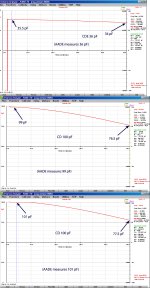You be the judge, W8BYA, but I propose to push this further off in an entirely different direction...lol, but it IS related to LED lighting on tractors.
My Terramite T7 came with an amber beacon on the roof. The original (strobe based, talk about RFI) died, and I decided to replace it with one of the cheap, LED based offerings. Long story short, I went through 3, made by 2 manufacturers. All of them died within the first few hours of use. The failure mode was the destruction of the driver chip. After the second one, I measured ambient and running voltages on the machine, and all was nominal. Tops was about 13.9VDC running with a fully charged battery. I figured I had settled on a poorly designed unit that couldn't handle a high duty cycle in the Texas heat, and recently got a unit from Tractor Supply that is a re-design of an un-impressive one they sold a few years ago. I installed it, and it worked great till the second time I started the machine, and now it's dead. If I take it apart I am expecting to find another cratered driver.
The light bulb (the one in my head) finally went on. I am probably looking at starting motor generated transients, and I need to install something on the B+ line, or in line with the strobe to protect it from such events. I am currently deciding what specifically to use. I don't have a number for a suitable MOV or module or coil, and I'm wondering if anything comes to mind for the purpose. The strobe is wired to go on with the ignition, and I want to keep it that way (i.e., no switch).
I love my Terramite, but they sure don't have any parts installed in them that are not absolutely necessary, and apparently, some kind of electrical system surge suppressor is on that list. Now that I think about it, I don't even know if cars have a discreet component that fulfills that mission. Anybody have any ideas?

